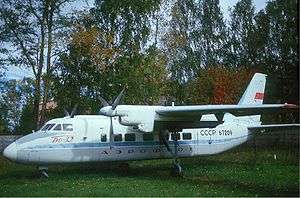Beriev Be-30
| Be-30 / Be-32 | |
|---|---|
 | |
| Aeroflot Beriev Be-32 | |
| Role | Airliner |
| Manufacturer | Beriev |
| First flight | 3 March 1967 |
| Primary user | Aeroflot |
| Produced | 1968-1976 |
| Number built | 8 |
The Beriev Be-30 (NATO reporting name "Cuff"[1]) is a Russian regional airliner and utility transport aircraft designed by the Beriev Design Bureau. It was developed specifically for Aeroflot local service routes using short, grass airstrips. It was also designed to be used in the light transport, aerial survey and air ambulance roles. It competed against the Antonov An-28 and the Czechoslovakian LET-410.
Design and development
The original design featured interconnected engines, so that in case of one engine failing, the remaining engine could drive both propellers. This feature was not implemented in the production version.
The first prototype flew on 3 March 1967, fitted with Shvetsov ASh-21 piston engines, while the first production prototype flew on 18 July 1968, using more powerful Glushenkov TVD-10 turboprop engines. The first deliveries to Aeroflot were in mid-1969.[2]
The Be-30 was designed for a flight crew of two with passenger arrangements for 14 (in the Be-30) to a maximum of 17 (in the Be-32) seated two abreast. Corporate shuttle configuration seated seven. The air ambulance configuration could accommodate nine stretcher patients, six seated patients and one medical attendant.
Three Be-30s and five Be-32s were built in the late 1960s before the program was terminated. In the early 1990s one of the original Be-32s was converted to a Be-32K demonstrator and presented at the 1993 Paris and Dubai air shows. It was painted in the colors of the now defunct Moscow Airways which had ordered 50 aircraft but ceased operations before any could be built or delivered.
In September 1996 it was announced that the Be-32 would be produced by IAR in Romania, but these plans were later denied. In 1998 it was stated that the Be-32K would be built by Taganrog Aviation, but flight testing was reportedly still underway in 1999. Apparently there has not been progress in recent years, and as far as is known, no new aircraft have been built since the mid-seventies.
Variants
- Be-30 Prototype first flew on 3 March 1967, powered by two 550 kW (740 hp) ASh-21 piston radial engines, driving three-blade constant speed propellers. Fuel capacity 1,000 kg (2,204 lb).
- Be-30: Production model
- Be-30A: With 'high-density' seating for 21-23 passengers
- Be-32: Upgraded model first displayed in 1993. Two 754 kW (1011shp) Glushenkov (Omsk) TVD-10B turboprops driving three-blade constant speed propellers.
- Be-32K: 'Westernized' version with two 820 kW (1100shp) Pratt & Whitney PT6A-65B turboprops driving three-blade Hartzell reversible pitch propellers. Fuel capacity 2250ltr (594USg)
Operators
Specifications (Be-30)
General characteristics
- Crew: two
- Capacity: 14-16 passengers
- Length: 15.7 m (51 ft 6 in)
- Wingspan: 17.0 m (55 ft 9 in)
- Height: 5.52 m (18 ft 2 in)
- Wing area: 32 m² (340 ft²)
- Empty weight: 3,607 kg (7,937 lb[2])
- Useful load: 1,500 kg (3,300 lb)
- Max. takeoff weight: 5,860 kg (12,920 lb)
- Powerplant: 2 × Glushenkov TVD-10 turboprop engines, 708 kW (950 shp) each
Performance
- Maximum speed: 480 km/h (260 kn, 300 mph) at 2,000 m (6,500 ft)
- Cruise speed: 460 km/h (250 kn, 290 mph) at 2,000 m
- Range: 1,300 km (700 nmi, 810 mi)
References
- ↑ Parsch, Andreas; Aleksey V. Martynov (2008). "Designations of Soviet and Russian Military Aircraft and Missiles". Designation-Systems.net. Retrieved 2010-04-13.
- 1 2 Green, William, The Observers Book of Aircraft, Frederick Warne & Co. Ltd, 1970. ISBN 0-7232-0087-4
- "Beriev Be-30/32". airliners.net. Retrieved 2006-08-18.